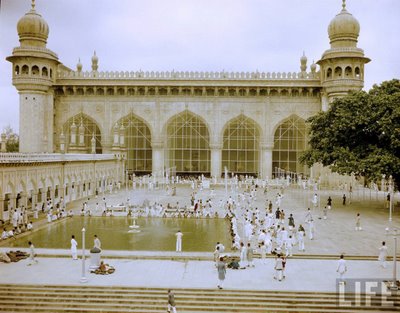Mecca masjid is one of the oldest masjids in the city and easily the biggest. Muhammed
Quli Qutub Shah began building it in 1617 under the supervision of Mir Faizullah
Baig and Rangiah Choudhary. Mughal emperor Aurangzeb completed the construction
in 1694. It took 77 years to come up as the magnificent edifice we see today. Like
many other ancient buildings in the city, the mosque is a granite giant with awe-inspiring
innards. The main hall of the mosque is 75 feet high, 220 feet wide and 180 feet
long, big enough to accommodate ten thousand worshippers at a time.
Mecca masjid is just a hundred yards southwest of the historic Charminar. Between
Muhammed Quli Qutub Shah and Aurangzeb, Abul Hasan Tana Shah of Golconda also continued
the task launched by the Qutub Shahi kings. It is believed that Muhammed Quli commissioned
bricks to be made from earth brought from Mecca and inducted them into the construction
of the central arch of the mosque, which explains the name of the mosque.

Fifteen graceful arches support the roof of the main hall, five on each of the three
sides. A sheer wall rises on the fourth side to provide mehrab. The three arched
facades have been carved from a single piece of granite, which took five years to
quarry. More than 8,000 masons and workers were employed to build this grand mosque.
Mohammed Quli Qutub Shah himself laid the foundation stone of the mosque, when he
failed to find one person who had never missed his prayers. The king seemed to be
the only person who never missed on his prayers ever since he was 12 years of age.
“It is about 50 years since they began to build a splendid pagoda in the town which
will be the grandest in all India when it is completed. The size of the stone is
the subject of special accomplishment, and that of a niche, which is its place for
prayer, is an entire rock of such enormous size that they spent five years in quarrying
it, and 500 to 600 men were employed continually on its work. It required still
more time to roll it up on to conveyance by which they brought it to the pagoda;
and they took 1400 oxen to draw it,” says Tavernier in his travelogue.
As the tourist gets past the main gateway and enters a huge plaza, a large man-made
pond of bluish waters greets him. On the edge of the pond are two stone and slab
benches and whoever sits on them, according to legend, returns to sit on them again.
A room in the courtyard is presumed to house the hair of prophet Mohammed. At the
peak of the minarets flanking the masjid is an arched gallery and above that a smallish
dome and a spire. Inscriptions from Quran adorn many of the arches and doors.
|